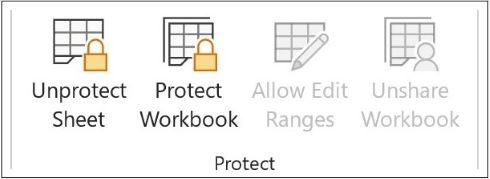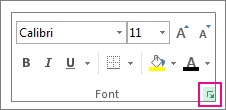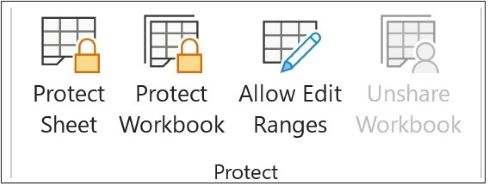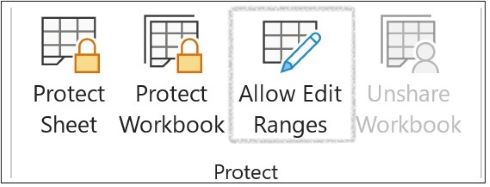By default, protecting a worksheet locks all cells so none of them are editable. To enable some cell editing, while leaving other cells locked, it’s possible to unlock all the cells. You can lock only specific cells and ranges before you protect the worksheet and, optionally, enable specific users to edit only in specific ranges of a protected sheet.
Lock only specific cells and ranges in a protected worksheet
Follow these steps:
- If the worksheet is protected, do the following:
- On the Review tab, click Unprotect Sheet (in the Changes group).

- Click the Protect Sheet button to Unprotect Sheet when a worksheet is protected.
- If prompted, enter the password to unprotect the worksheet.
- On the Review tab, click Unprotect Sheet (in the Changes group).
- Select the whole worksheet by clicking the Select All button.

- On the Home tab, click the Format Cell Font popup launcher. You can also press Ctrl+Shift+F or Ctrl+1.

- In the Format Cells popup, in the Protection tab, uncheck the Locked box and then click OK.
This unlocks all the cells on the worksheet when you protect the worksheet. Now, you can choose the cells you specifically want to lock.
- On the worksheet, select just the cells that you want to lock.
- Bring up the Format Cells popup window again (Ctrl+Shift+F).
- This time, on the Protection tab, check the Locked box and then click OK.
- On the Review tab, click Protect Sheet.

- In the Allow all users of this worksheet to list, choose the elements that you want users to be able to change.
- In the Password to unprotect sheet box, type a password for the sheet, click OK, and then retype the password to confirm it.
- The password is optional. If you do not supply a password, any user can unprotect the sheet and change the protected elements.
- Make sure that you choose a password that is easy to remember, because if you lose the password, you won’t have access to the protected elements on the worksheet.
Unlock ranges on a protected worksheet for users to edit
To give specific users permission to edit ranges in a protected worksheet, your computer must be running Microsoft Windows XP or later, and your computer must be in a domain. Instead of using permissions that require a domain, you can also specify a password for a range.
- Select the worksheet that you want to protect.
- On the Review tab, in the Changes group, c
- lick Allow Users to Edit Ranges.

- This command is available only when the worksheet is not protected.
- Do one of the following:
- To add a new editable range, click New.
- To modify an existing editable range, select it in the Ranges unlocked by a password when sheet is protected box, and then click Modify.
- To delete an editable range, select it in the Ranges unlocked by a password when sheet is protected box, and then click Delete.
- In the Title box, type the name for the range that you want to unlock.
- In the Refers to cells box, type an equal sign (=), and then type the reference of the range that you want to unlock. You can also click the Collapse Dialog button, select the range in the worksheet, and then click the Collapse Dialog button again to return to the dialog box.
- For password access, in the Range password box, type a password that allows access to the range. Specifying a password is optional when you plan to use access permissions. Using a password allows you to see user credentials of any authorized person who edits the range.
- For access permissions, click Permissions, and then click Add.
- In the Enter the object names to select (examples) box, type the names of the users who you want to be able to edit the ranges. To see how user names should be entered, click examples. To verify that the names are correct, click Check Names.
- Click OK.
- To specify the type of permission for the user who you selected, in the Permissions box, select or clear the Allow or Deny check boxes, and then click Apply.
- Click OK two times. If prompted for a password, type the password that you specified.
- In the Allow Users to Edit Ranges dialog box, click Protect Sheet.
- In the Allow all users of this worksheet to list, select the elements that you want users to be able to change.
- In the Password to unprotect sheet box, type a password, click OK, and then retype the password to confirm it.
- The password is optional. If you do not supply a password, then any user can unprotect the worksheet and change the protected elements.
- Ensure that you choose a password that you can remember. If you lose the password, you will be unable to access to the protected elements on the worksheet.
- If a cell belongs to more than one range, users who are authorized to edit any of those ranges can edit the cell.
- If a user tries to edit multiple cells at once and is authorized to edit some but not all of those cells, the user will be prompted to edit the cells one-by-one.
Ref: https://support.microsoft.com/en-us/office/lock-or-unlock-specific-areas-of-a-protected-worksheet-75481b72-db8a-4267-8c43-042a5f2cd93a